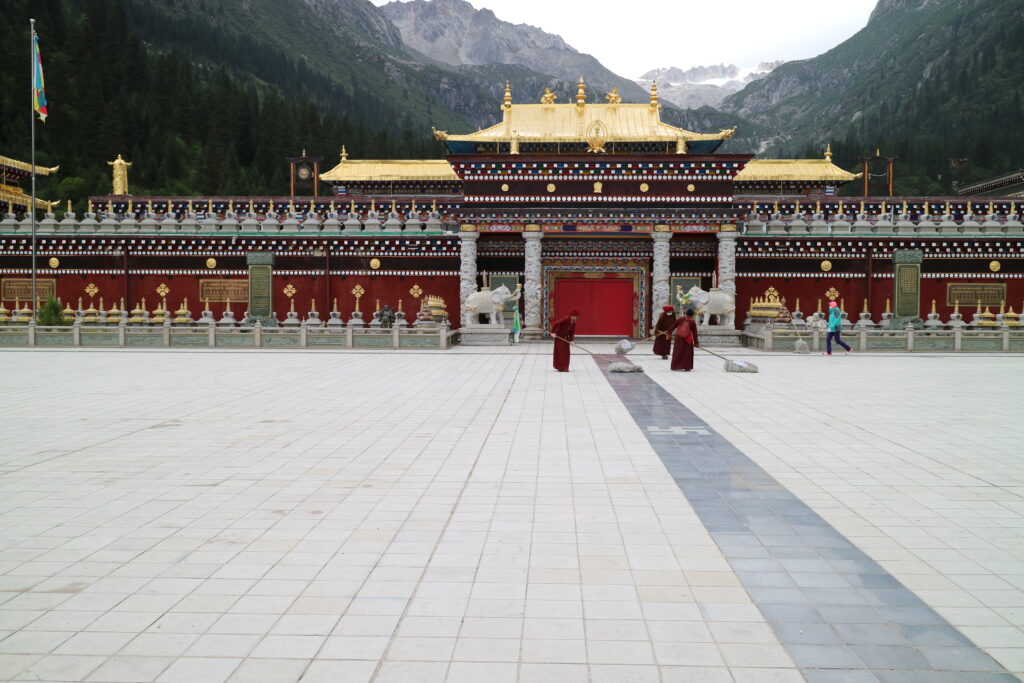
Dzogchen Monastery is one of the most important and influential monasteries of the Nyingma school of Tibetan Buddhism. It is located in the remote Kham region of eastern Tibet, now part of Sichuan Province, China. Founded in the 17th century, Dzogchen Monastery is a center for Dzogchen teachings, the highest and most esoteric path of the Nyingma tradition, which emphasizes direct realization of the natural, primordial state of the mind.
Dzogchen Monastery was founded in 1684 by Pema Rigdzin (1625–1697), also known as the 1st Dzogchen Rinpoche, a revered Nyingma master and tertön (treasure revealer). The monastery was established in response to the growing need for a place where the Dzogchen teachings could be practiced and preserved.
The monastery became one of the “Six Mother Monasteries” of the Nyingma school, alongside Mindroling, Shechen, Katok, Palyul, and Dorje Drak. These six monasteries are considered the primary centers of learning and practice for the Nyingma tradition.
Over time, Dzogchen Monastery grew into one of the largest and most influential monastic institutions in Kham, housing thousands of monks at its peak.
The title of Dzogchen Rinpoche refers to the successive reincarnations of the monastery’s founder, Pema Rigdzin. Each Dzogchen Rinpoche has been a highly realized master, guiding the monastery and its followers in the path of the Great Perfection.
The current Dzogchen Rinpoche, the 7th Dzogchen Rinpoche, continues this tradition, overseeing the monastery’s activities and providing spiritual guidance to the community. He has also played a role in sharing the Dzogchen teachings internationally, especially with Western students.
In addition to the Dzogchen Rinpoche, many renowned Nyingma masters have trained and taught at Dzogchen Monastery, making it a significant place for the transmission of lineage teachings.
Dzogchen Monastery is a vast complex situated in a stunning valley, surrounded by rugged mountains and alpine scenery. The main temple (known as Lhakhang), decorated with traditional Tibetan Buddhist art, houses statues, thangkas, and relics, creating a sacred space for practice.
The monastery’s large assembly hall (Tibetan: dukhang) serves as the primary place for group rituals, prayers, and teachings. Surrounding the main temple are various buildings used for study, meditation, and housing for monks and visiting practitioners.
Close to the monastery is the famous Zangdok Palri temple, built as a representation of Guru Rinpoche’s (Padmasambhava’s) celestial abode. This sacred structure is known for its elaborate artistry and spiritual significance.
Dzogchen Monastery is home to the renowned Shri Singha Shedra, one of the most respected monastic universities (shedra) in the Nyingma tradition. The shedra provides advanced Buddhist education, offering courses on sutra, tantra, philosophy, and Dzogchen practice.
The curriculum at Shri Singha Shedra includes the study of the thirteen great texts of Buddhist philosophy, Tibetan grammar, and the Nyingma tantras. It has produced numerous esteemed scholars and meditation masters. Many monks from across Tibet and abroad travel to Shri Singha Shedra to receive traditional Nyingma education. The shedra is also known for its connection with some of the most illustrious Nyingma scholars, such as Mipham Rinpoche and Patrul Rinpoche, both of whom had ties to Dzogchen Monastery.
Dzogchen Monastery is renowned for its emphasis on retreat practice, especially the three-year, three-month retreat common in the Nyingma tradition. Practitioners engage in solitary retreat, focusing on Dzogchen meditation and tantric practices under the guidance of qualified teachers.
The surrounding mountains offer ideal conditions for meditation retreats. Hermitages and retreat centers are scattered throughout the area, where practitioners live in isolation to deepen their meditative experiences.
Retreatants typically focus on Ngöndro (preliminary practices) before advancing to higher Dzogchen practices, where the nature of mind is directly realized.
 Tibet World Travel Tibet Tour, Tibet Trip, Tibet Travel, Tibet Train, Tibet Trekking,
Tibet World Travel Tibet Tour, Tibet Trip, Tibet Travel, Tibet Train, Tibet Trekking,
